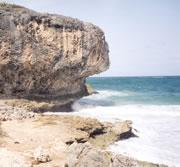 Sea levels have risen and fallen by as much as 30 metres over just a few thousand years.© William G. Thompson
Sea levels have risen and fallen by as much as 30 metres over just a few thousand years.© William G. ThompsonA new reconstruction of past changes shows that the level of the oceans varied more dramatically during between ice ages than was previously thought, implying that the global climate during these intervals was not as stable as most scientists think.
One of the best ways to document the rising and falling of the oceans over time is by coral dating. Coral thrives in shallow waters with plenty of sunlight; as sea level rises, however, coral grows in stacks from the murky sea floor, forming terraces to reach the rays nearer the surface.
The age of the coral in a terrace is determined by monitoring the rate of decay of radioactive uranium, which is present in the corals, into the element thorium. But coral readily exchanges uranium with seawater, thereby complicating the dating process.
“The real punchline is that sea level changes more frequently than has been previously thought.”
William Thompson
Woods Hole Oceanographic Institution
To correct for this, William Thompson and Steven Goldstein, then at the Lamont-Doherty Earth Observatory of Columbia University, developed a new method for determining the age of coral to generate a record of past sea levels, which they report in this week's issue of Science1.
The two scientists essentially described the nature of this open-system by "rewriting the decay equations," explains Thompson. Now, "coral ages make a lot more sense."
Using their new dating system, Thompson and Goldstein reassessed past measurements of uranium decay, and reconstructed sea-level changes from between 70,000 and 240,000 years ago. And what they found was very surprising, explains Thompson. "This record shows high-frequency changes that are very consistent and persistent."
"It is the first time that such variability has been accurately dated with so many corals," says Mark Siddall, an oceanographer at the University of Bern, Switzerland.
Large variations in sea level of up to 100 metres are caused by the growth and melting of global ice sheets. These changes are commonly thought to occur on a maximum 100,000-year timescale based on variations in Earth's orbit. Thompson and Goldstein, however, uncovered sea-level changes of as much as 30 metres that occurred at intervals of 3,000-9,000 years - relatively rapid oscillations.
"The real punchline is that sea level changes more frequently than has been previously thought," says Thompson. What's more, sea-level change can help to explain the overall climate system. This means that global climate is more variable than has been thought, he adds.
ADVERTISEMENT
In addition, significant sea level change was detected during interglacial periods similar to the one we are currently in. Experts had previously thought that sea level remains constant during such intervals. "This raises the question as to the future stability of sea level during our own interglacial," explains Siddall.
"This information should spur us on to understand ice-sheet dynamics better so we can assess the possibility of future changes," comments Gideon Henderson, an earth scientist at the University of Oxford, UK.
Woods Hole Oceanographic Institution
